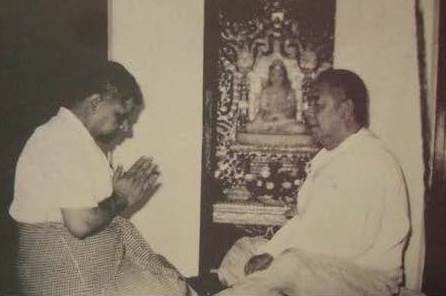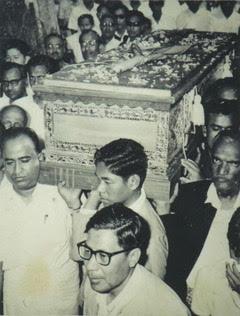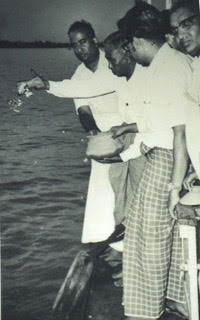by Sayagyi U Goenka
To live the life of morality is the quintessence of every spiritual teaching. However, the Buddha was not interested in merely giving sermons. He taught us to take the next important practical step of samādhi, meaning mastery over the mind.
Developing mastery over the mind needs an object of meditation for concentration. There were many objects to concentrate the mind. The Buddha himself gave many objects, and of these, the most effective was one's respiration. He called this Ānāpāna sati: developing the faculty of awareness of inhalation and exhalation.
Respiration is a common human activity. Nobody can object to the practice of awareness of respiration. The breath cannot be obviously labelled as Muslim or Hindu, Christian or Jewish, Buddhist or Jain, Sikh or Parsi, Caucasian or African or Asian, male or female,
Ānāpāna requires us to remain aware of the natural breath, as it is, on the area below the nostrils and above the upper lip. It is the one-pointed concentration at the middle of the upper lip. We observe the natural breath. No regulation of the breath.
As the mind gets concentrated on this small area, the mind becomes sharper, more sensitive. After three days of practice, you start feeling physical sensations on this part of the body. And then, you turn to the next stage training: paññā i.e experiential wisdom or insight.
From ignorance of inner reality to wisdom
The Vipassana practitioner observes the changing sensations throughout the physical structure, from the top of the head to the tips of the toes. In doing so, it can be noticed that these bodily sensations are closely related to what happens in the mind. It becomes clear that before performing an unwholesome action, some impurity is generated in one's mind: hatred before violence or killing, greed before stealing, intense passion (sexual craving) before sexual misconduct.
The truth becomes clear: we cannot harm anyone without first harming oneself.
Negativities such as anger, hatred, greed, ill will, jealousy, egotism and fear makes a person unhappy, miserable and violent. These impurities agitate the mind. And when the mind is agitated, this person distributes the agitation to others.
First harming oneself, and then harming others. This law of nature is realized within the framework of one's own mind and body.
Someone committing unwholesome actions may seem outwardly happy, but this "happiness" is like burning charcoal covered with a thick layer of ash. The burning goes on inside because of the mental negativities - yet the individual is totally ignorant of what is happening within.
This is avijjā or moha - ignorance.
For the Buddha, ignorance is not the lack of worldly knowledge, but the lack of awareness of what is happening within oneself - this veil of ignorance that causes so much misery.
The practice of Vipassana tears apart this veil of ignorance.
By objectively observing the arising, passing sensations in Vipassana practice, the realization deepens:
"Look, I am generating misery for myself by generating tanhā in response to these sensations. When they are pleasant, I generate craving and when they are unpleasant, I generate aversion. Both make me miserable. And look, I have the solution now. When I understand the impermanent nature of sensations and maintain equanimity, there is no tanhā, no craving and no aversion. The old habit pattern of the mind starts changing and I start coming out of misery."
This is vijjā or wisdom.
This practical self-realized wisdom has nothing to do with any philosophical or sectarian belief. It is the truth about one's happiness and misery. Anyone can experience this truth within by taking steps on the path of Vipassana.
Vipassana Path of direct experience
The Vipassana path is to experience the Four Noble Truths - at the level of bodily sensations or bodily feeling.
When working with sensations, we work at the depth of the mind.
Whatever arises in the mind is accompanied by sensations within the body: vedanā-samosaranā sabbe dhammā.
Every thought that arises in the mind is accompanied by a sensation within the body: vedanā-samosaranā sankappavitakkā.
This was the unique and great discovery of the Buddha.
Another important discovery of the Buddha: we generate craving (tanhā) in response to the sensations. This was not known to the other teachers before the time of the Buddha, at the time of Buddha. The teachers before the Buddha and at the time of the Buddha kept advising people not to react to the sensory objects that come in contact with the sense doors: eyes with a visual object, nose with smell, ears with sound, and so on.
They taught, "When sensory objects come in contact with your senses, do not react by judging them as good or bad; do not react with craving or aversion."
This teaching was already in existence. But the Buddha went beyond. He said: you are not reacting to these objects. He gave the example of a black bull and a white bull (one representing the sense doors and the other the sense objects) tied together with a rope. Neither the black nor the white bull is the bondage; the rope is the bondage.
The Buddha said that the rope of tanhā (craving) is the bondage and that the individual generates craving or aversion as blind reactions to vedanā (sensations): vedanā paccayā tanhā.
This was the great discovery of the Enlightened One, the sammasambuddha.
Being with reality, not apparent reality
As long as you are not aware of sensations, you react to outside objects, thinking, "This is beautiful", "This is ugly".
You struggle with the apparent reality, the surface. The black bull or the white bull appears as the cause of the bondage. But the real bondage is the rope of craving and aversion - as a reaction to sensations.
An alcoholic thinks that he is addicted to alcohol. He is actually addicted to the sensations he feels when he drinks alcohol.
The attraction is not to anything outside. The reaction of attraction is to one's own pleasant sensations within.
Observe sensations objectively, and start coming out of ignorance of the reality within.
Experiencing the impermanent nature of sensations, one generates paññā (experiential wisdom) in response to vedanā (sensations). This is the law of nature, Dhamma. Whether there is a Buddha or no Buddha, Dhamma remains eternal.
The Buddha said:
“Uppādā vā tathāgatānam anuppādā vā tathāgatānam, thitāva sā dhātu dhammatthitatā dhammaniyāmatā idappaccayatā. Tam tathāgato abhisambujjhati abhisameti. Abhisambujjhitvā abhisametvā ācikkhati deseti paññāpeti patthapeti vivarati vibhajati uttānīkaroti. 'Passathā'ti cāha.”
"I have experienced this law of nature, the Law of Dependent Origination, within myself; and having experienced and understood it I declare it, teach it, clarify it, establish it and share it to others. Only after having experienced it, I declare it."
This is the bold declaration of a super scientist - one who discovers and shares the fundamental truths of nature, after realizing through direct experience.
The junction of sensations
The feeling of sensation is the crucial junction, of two paths going in opposite directions: blind reaction to unpleasant or pleasant sensations - this path of misery. Or equanimity to sensations - the path of real happiness.
The sensations are the root - the root from which habit patterns can be changed.
As long as the root is neglected, the poisonous tree will grow again even if the trunk is cut.
The Buddha said:
“Yathāpi mūle anupaddave dalhe, chinnopi rukkho punareva rūhati
Evampi tanhānusaye anūhate, nibbattati dukkhamidam punappunam”.
Just as a tree with roots intact and secure, though cut down, sprouts again;
-even so, while latent craving is not rooted out, misery springs up again and again.
To be fully liberated from mental defilements, work at the root of the mind. Each individual must cut the roots of craving.
When the entire forest is withered, each tree has to be nurtured, its roots cleared of disease, and then watered. Then, the entire forest will bloom again.
Similarly, for the betterment of society, each individual has to change himself or herself for the better. For society to become peaceful, each individual has to become peaceful.
The individual is the key. Vipassana gives the individual the key to purifying the mind, and change life for the better.
from 'Buddha, the Super-Scientist of Peace', Sayagyi U Goenka's address the United Nations in 2002, on the occasion of Vesakha, the full moon day of May - celebrated each year as the day marking the birth, the enlightenment and the passing away of Gotama the Buddha.
In 2002, Goenkaji was touring North America during the month of Vesakha, teaching Vipassana and giving Dhamma talks - as part of an epic Vipassana journey of more than 24,000 miles (38,000 kms) across 35 cities in North America, over a period of nearly four months.
***




